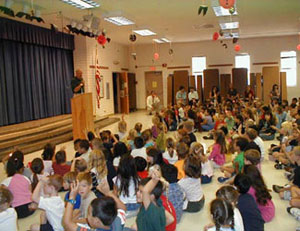Keeping the Walking School Bus Going
Getting a program off the ground requires time and energy. It makes sense to plan how it will continue over time so that families can continue to benefit. Because walking school buses are often parent-led, volunteer turnover may occur as children get older and move on to other schools. Developing leaders and keeping the program visible and exciting can help the walking school bus thrive.
A. Develop leaders
It can be very difficult to have one person responsible for all of the organizing and leadership for the program. Not only can it cause burnout but new parents or other individuals need to be prepared to take over when leaders move on. Co-leaders, preferably with children of different ages, are one solution. The next year’s leader “shadowing” the current leader will also help with a smooth transition to continue the program.B. Keep the walking school bus visible and exciting.
Children and adults want to be a part of popular programs and enjoy being recognized for it. Share the numbers of walkers with the school and community, reward students for participating and recognize volunteers for their dedication. Whenever there is an opportunity to discuss the success of the program, there is also a chance to ask for volunteers and educate the public about the benefits of a walking school bus and physical activity in general.

Dunham Elementary School, Tucson, AZ

Students show off their frequent walker cards used as part of their walking school bus.
C.P. Smith Elementary School, Burlington, VT
Children and adults both appreciate being recognized for their efforts. Some ways to do so include:
- At school assemblies and other events, make announcements about the number of children involved and miles walked. Encourage students to break
records for the number of walkers and bicyclists.
- Submit school newsletter articles about walking school bus adventures such as animals seen while walking. Ask children to write or draw about what they see on their way to school.
- Recognize regular walkers at school assemblies.
- Reward walkers with prizes after they have walked a specific number of miles or days.
- Provide rewards for children on unannounced “surprise” recognition days.
- Advertise in school communications and include names of participating volunteers and children.
- Thank volunteers with small gifts. For example, local businesses in one community donated gift cards for walking school bus leaders.
- Help children write thank you notes to adult volunteers.
Making the walk fun will keep children and adults involved. Below are a few examples used by other communities:
- Encourage children to name their bus. This makes it fun and develops a sense of ownership.
- Have a theme day. This might include wearing clothing in support of a sports team, holding a “sneaker” day or all walkers wearing the same color.
- Talk to children about why the walking school bus is important and how they are doing something good for themselves, their community and their environment.
- Make it special to be a part of a walking school bus by providing children with a ‘book bag tag’ or other emblem.
